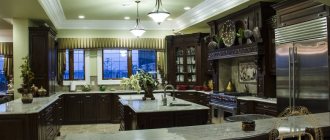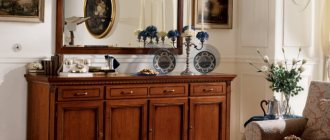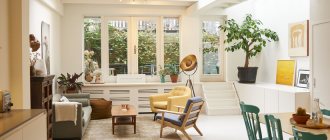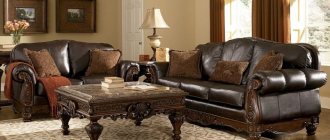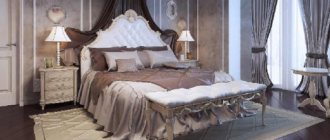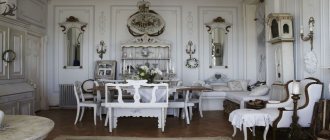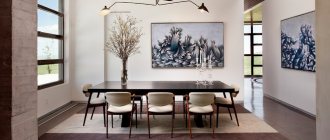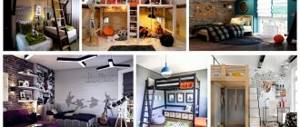Why is one design considered ordinary and another elite? How to do all the work correctly so that sophistication does not turn into a complete lack of taste?
To do this, you need to know the main features inherent in elite interior design, and all the nuances of implementation. In this article we will look at all these indicators.
Rich interior design
If you decide to decorate your house by creating a rich interior, then, of course, you understand that there is no point in using it for small small rooms.
The expression “rich” itself suggests that you need a lot of space in order to realize all your ideas. Residential complexes or country houses are suitable for this.
Due to the fairly large area of such buildings, by performing design work in them, it is possible to additionally organize rooms for recreation and various types of entertainment in them. This could be a sauna, hammam, home cinema, etc.
Of course, each person can organize these zones depending on their desires. If, for example, the customer studies the stars, then an observatory can be made in one of the rooms, as an option.
What houses do the richest people in the world live in?
“Antilla”
Billionaire
Warren Buffett
, who occupies third place in the ranking of the richest people in the world, can rightfully be considered one of the most modest people on Earth...
The famous financier still lives in the house, which he purchased in 1958 for 31.5 thousand dollars.
Buffett's mansion, decorated with gray plaster, is located in the city of Oman (USA, Nebraska). Its area is slightly larger than 557 square meters and it contains five rooms. The house has everything a 79-year-old could need, including a handball court to keep fit. Simplicity fits well with Buffett's investment philosophy. “If you don't feel like you'll be comfortable owning something for ten years, then you shouldn't own it for ten minutes,” the magazine quotes him as saying. However, Forbes notes, other billionaires are not so thrifty. As an example, the magazine cites computer tycoon Michael Dell
(37th on the Forbes list).
“Dell talks about a simple life, but his residence in Austin, Texas, reaches 3,066 thousand square meters - locals call the house “the castle” due to the high walls and secret security around the 8-hectare estate surrounding the house...” However, the house Della still cannot be called outstanding, unlike the “mega-mansions” of other entrepreneurs included in the list of the richest people in the world... For example, in the 27-story house under construction by Mukesh Ambani
(number four among billionaires), who made his fortune in oil, gas and chemical industry, no two floors are the same - each is made of different materials.
The high-rise is located in Mumbai and is known as “Antilla”. Steel king Lakshmi Mittal,
only one line behind Ambani, paid more than $120 million for his house in the prestigious Kensington area of London. The mansion, located between Kensington Palace and the estate of the Sultan of Brunei and decorated with marble from the quarry where marble was taken from the Taj Mahal, has Turkish baths and a garage for 20 cars.
Diamond tycoon
Lev Leviev, who is not even included in the top hundred of Forbes, distinguished himself with an unusual house.
The billionaire, ranked 655th on the magazine's list, purchased a mansion in London called Palladio in 2008 for $65 million. The house has a bulletproof front door, a gold-lined swimming pool, its own movie theater and even a hair salon.
In turn, Oracle founder
Lawrence Ellison
(the sixth richest in the ranking) did not skimp on immediately investing $200 million in the creation of a small personal village of more than a dozen houses on the Pacific coast in Malibu. Ellison also owns another estate in California - this time of 10 buildings. The Woodside property was inspired by a 16th-century imperial palace in Kyoto and cost the billionaire $200 million to complete.
Against this background, the estate of the second wealthiest person in the world,
Bill Gates,
on the shores of Lake Washington near Seattle with an area of 6.132 thousand square meters seems almost modest. According to the publication, it only has a swimming pool with an underwater music system, a gym, a dining room for 24 seats and a lift for out-of-shape guests who cannot climb the 84 steps.
But the Californian ranch of director
George Lucas
(ranked 316th on the Forbes list), known to everyone as the creator of the epic Star Wars, houses not only a house, but also a Skywalker Sound studio, which even has its own fire brigade.
American fashion trendsetter
Ralph Lauren
bought a stone and wood house in New York for $2.8 billion.
This house once belonged to John Lennon and Yoko Ono. Donald Trump,
whom Forbes placed in 488th position on the list of the wealthiest people on Earth,
can also work from home The businessman's apartment, the magazine explains, is located on the upper floors of Trump Tower in Manhattan in New York and is furnished in the style of Louis XIV. “Despite the expensive decor, Trump can say that the best thing about his place is the location, which allows him to get to his office in the same skyscraper using just one elevator. And it’s a real luxury that billionaires can afford to have an extravagant home close to work,” the publication concludes. Steve Jobs his mansion, located in the city of Woodside, in the south of San Francisco, eight years ago. This is not just an American box with holes for windows, but a building built in the style of the Spanish Colonial Revival. Jobs bought the house back in 1984. He lived there for 10 years, then the house was rented out, and since 2000 it has been empty and Jobs wanted to demolish the mansion and build a modern cottage in its place. However, the city council opposed the millionaire's intentions, declaring that the house was of historical value. In 2004, Jobs still managed to convince the Woodside authorities of the need to demolish his house, but in 2006, the court ordered Jobs to explain why the mansion should be demolished and what alternative solutions might be. In 2009, the millionaire, after a public discussion of the project, finally received permission to demolish the building...
Finishing for a rich interior
For this type of premises, fairly high-quality and expensive finishing is used.
For example, if you use natural wood, if you want stone, then, of course, you also choose natural marble or onyx. Such houses, as a rule, combine expensive textures of stones, glass, crystal products and mirrors.
Regardless of your capabilities, there should be moderation in everything. When selecting all the elements for the interior, you must not overdo it. So that a beautiful and rich interior does not turn into tasteless and uninteresting.
Another idea that can be implemented in decorating the rich interior of an apartment or house are architectural elements.
They will make the interior more complex and unique. The following elements can be applied:
- Columns;
- Sockets of different types;
- Vaulted ceilings and others.
But here, just as when choosing materials for finishing, the same approach is needed. But you shouldn’t use as many architectural elements as possible in one room.
Your task is not to create an interior that will go down in history, but to arrange everything for a comfortable stay.
Who creates the interior design of luxury apartments and houses?
The interior design of luxury apartments and houses is always carried out by professional studios and renowned designers. Agree that it is not so easy to imagine an oligarch whose day is scheduled minute by minute, hanging pictures on the walls and hammering nails into the wall. However, it is difficult to imagine that a representative of the elite would prefer a sports tights from the Chinese market to a suit from Dior or Armani. The rich and famous love to surround every aspect of their life with exclusivity. Therefore, when selecting a design studio, they focus both on the professionalism of the contractor and on the well-known name of the designers.
The design studio of Ruslan and Maria Green has extensive experience working with luxury properties. Our portfolio includes many interiors of apartments and houses located in prestigious residential complexes of the capital and premium cottage villages. For each of these objects, famous designers Ruslan and Maria Green develop an original interior. Today, the Design Studio of Ruslan and Maria Green offers customers several packages of services, the price of which already includes not only the design sketches themselves, but also repair work, finishing materials, and furniture. To create an elite interior design for an apartment or house, the “LA” and “Rome” packages are most suitable. within the framework of these comprehensive proposals it will cost 50,000 rubles/sq.m. m. Package “Paris”, the cost of which is 60,000 rubles / sq. m. m., suitable for connoisseurs of refined classics. And finally, those who can afford a real dolce vita should pay attention to our offer. If you choose this package, the cost of the finished renovation will cost 90,000 rubles/sq.m. m.
Rich interior
lives up to its name and is recognized show status. in this example it is different from most and therefore attracted our attention. It does not have the glamor, pathos and excessive luxury inherent in many interiors, which many owners flaunt for show, to the detriment of not only style, but often common sense. Often rich people choose lush classics, palace decor and abundant gilding, which turns the apartment into a palace.
This interior is rich not in details (expensive ostentatious items), but in the overall presentation, in which the merit of the interior designer is visible. The spacious apartment breathes the same style and each room complements the picture of modern design. The composition is based on wall panels, which set the overall beige tone. Upholstered wall panels are used only in the master bedroom in the form of a large headboard.
Lighting
Just as all of the above is important in the interior, lighting is an important element in the created interior. If for an ordinary interior it will be sufficient to place several built-in lamps on the ceiling, or to have a couple of sconces.
This will not be enough for a rich interior. Here you need the maximum amount of artificial light.
These can be lighting around the perimeter of the ceiling, chandeliers of quite large sizes, lamps designed in a cascade, illuminated fireplaces and stained glass, and many other design options.
A rich inner world: how young Russian designers are breaking our stereotypes about interior design
It sounds boring and unclear. What does this have to do with the beautiful and creative word “design”? Designers are such bright, creative people (men in black, ladies in cleavage), leading Instagram about the latest trends in everything, discussing the color of the season “living coral”, taking selfies of their loafers and pumps against the backdrop of freshly poured concrete, traveling to Milan and Paris for inspiration and to exhibitions of branded furniture and being part of a narrow circle of representatives of the “100 best in the profession”. In fact, this elegant life, like any other, has a strict economic basis: methods of obtaining what the interiors are filled with, that is, materials, furniture, lamps and accessories, play a huge role in the success of design work. Designers do not live solely on fees from clients. Many of them receive kickbacks from suppliers: some bribe for bringing a client to this particular store and not another. Many designers, in addition to suggestions on style and architectural solutions, provide the client with the purchase of everything necessary for the project directly from suppliers, bypassing retail dealers. This is how it happened historically 20 years ago, when at the dawn of the formation of the Russian interior market and at the time of the economic crisis, both of these practices were greatly shaken. Many foreign brands simply left the Russian market, like the American chain Crate & Barrel, for example, or dozens of small Italian manufacturers, whose products, which had sharply risen in price due to the euro exchange rate, lost their attractiveness for Russian buyers. However, people doing renovations of varying levels of cost and quality in Russia still needed interior items. The lower segment of the market was closed by construction stores like Leroy Merlin and the irreplaceable IKEA. The upper segment continued to buy European brands, despite the price increase. But the middle segment, which is becoming more and more numerous in the field of interior design (many projects today are carried out in small apartments, some of them are intended for rent and are done, accordingly, quite economically), it was necessary to complete them with something. And now the finest hour has come for Russian furniture production. And, naturally, Russian “object” designers - people who design furniture and lighting, and not interiors in general.
It turned out that over 20 years of development of the interior market in Russia, a significant number of industries have accumulated that are capable of producing items of the required quality, in the required quantities and in compliance with the required deadlines. The only question is what these products look like and how well they correspond to international, let’s say, ideas about beauty. And the presence of a decent “material base” (high-quality production facilities) provided Russian object designers with the opportunity to expand.
Here we need to make a small digression and explain what the figure of an object designer is in general. This is a profession at the intersection of art and engineering (we remind you that to design means “to design”): the designer must not only come up with a beautiful and convenient object, but also develop, together with the manufacturer, the technology and economics of how it is created. Before the advent of the era of industrial production, there was no talk of any “object designers” - there were simply cabinetmakers who made beautiful one-piece things, like the great Frenchman Andre-Charles Boulle. Then, first Chippendale, and then the Thonet brothers, made furniture production widespread, but their names were only a designation of the brand, not the authorship of the items. The figure of the designer emerged in the furniture business at the turn of the 19th and 20th centuries, during the Art Nouveau era: characters like William Morris in England and Jacques Emile Ruhlmann in France loudly declared their author's vision of things and thus protested against impersonal industrial design. But, paradoxically, the more industrialized production became, the more important specific designers became. Manufacturers began to use the names of furniture stars as a sales tool: today the price of a plastic chair created by Philippe Starck is several times higher than its cost.
Before the revolution, Russia followed the general course - our furniture made of Karelian birch, amazing in all respects, was anonymous, our answer to Morris and Ruhlman was Fyodor Shekhtel. In the USSR, an understandable breakdown occurred - after Alexander Rodchenko’s amateur attempts to design furniture in the spirit of constructivism, the era of mass furniture anonymity began. By the way, the design in the USSR was very good and in some places great, but no one was going to turn its authors into stars. Considering the fact that socialist life, for technical and ideological reasons, was ascetic and meager, there was no talk of any kind of residential interior design. Add to this that the pinnacle of happiness and taste in everyday life was the presence of a Yugoslav wardrobe “wall”, that everything foreign seemed to be the apogee of grace and beauty (it didn’t matter what it was, the main thing was that it was foreign). As a result, we get the state in which our compatriots met the collapse of the Union: the lack of habit and ability to live beautifully, combined with the confidence that “we” will still not be able to do well.
The result of this complex of aesthetic inferiority was the notorious “European-quality renovations” and the hellish interior aesthetics of the 1990s: its “modern” version was a combination of bright yellow and blue, polished floors and spotlights throughout the ceiling running in tiers and waves, and the “classic” version was - walls completely covered with wood panels and gilded, plump purple sofas with fringe and multi-story crystal chandeliers. There was no talk of any Russian production or Russian design at that time - all this incredible beauty was brought from abroad, sold in tons, and everyone was happy.
The situation changed very slowly - clients appeared who had traveled abroad and seen normal interiors. A generation of “new clients” has grown up - the children of Russian rich people of the “first wave”, who were sent to study abroad and saw plenty of different things there. Demand was followed by supply: stores appeared that brought good modern and classic furniture to Russia. Designers appeared who learned not just to buy what was available, but to go to exhibitions, antique stores and flea markets and choose something unusual. Since the mid-2000s, Russian interiors have improved dramatically. In particular, designers began to regularly draw furniture in their projects based on individual sketches (an everyday practice for foreign designers): if you couldn’t buy the item you needed, you could make it yourself. But these were not systemic cases: in the field of furniture design as such, everything was silent. Young talents sadly brought models made from matches and plasticine to design exhibitions, showed renderings on the laptop screen and complained that there were no factories willing to invest in the production of their marvelous products. The pinnacle of success for a Russian designer with “furniture” ambitions was the inclusion of an item they designed in the catalog of some Italian factory. Thus, for many years, our main furniture stars were the architect Evgeny Polyantsev, who created several items for the Emmemobili brand, and the designer Elena Arkhipova, who successfully worked with the Prianera factory. Then they were joined by Yaroslav Rassadin, who managed to work for Roche Bobois, Koziol and Roca, and Dima Loginov, who makes lamps for Preciosa and Axolight.
Some successful designers are still following the path of designing things that are in demand by foreign manufacturers. In 2019, at the main world design exhibition Salone del Mobile.Milano, there was a downright Russian invasion: several serious Italian brands showed “Russian” items at once. So, for example, Mike Shilov made a dining set Bloom for the Minotti Collezioni brand, Tatyana Gorshkova - a chest of drawers and a mirror Frost for Arte Veneziana (a year earlier, the same Shilov made a pair of chest of drawers + a mirror Gonfalone for this Venetian brand), Olga Engel designed for the lighting brand MM Lampadari chandelier Jack.
All the designers from this trio are not newbies: Mike Shilov created, for example, a faucet for Cisal and a collection of carpets for Tapis Rouge, Tatyana Gorshkova has repeatedly designed furniture for her interiors. But Olga Engel is the only one in this company who is building a career specifically in product design. She builds successfully: the lamps and chairs she created are regularly exhibited at prestigious collection design forums, in particular in Brussels at Collectible and at Design Miami/Basel; Olga’s interests in Europe are represented by the French Galerie Armel Soyer. This is no longer just “there was no suitable bedside table for the nursery, I had to draw and make the right one”, this is a real international success.
Olga’s case is not an isolated one. Designer Igor Kurkin, in collaboration with the Russian foundry ARTVIVO, created a limited edition of Hawking lamps (named after the great physicist), and they are now presented in Zurich at the EXCEPTIS gallery. Another serious star case is designer Denis Milovanov, creator of the SOHA brand, whose inspired wooden sculptural and furniture objects are presented in the Rosewood gallery in Moscow, in Pavilion Antiques in Chicago and in the same Galerie Armel Soyer in Megeve.
Our Lefties have succeeded in creating one-piece collectibles. Well, what about Russian production? Everything is not bad with them either: the emergence of orders for the production of designer furniture from interior designers forced factories to develop, purchase equipment, solve functional problems - and as a result reach a new level of quality. Which, in turn, allows designers to do more and more interesting things. Among the productions whose work is definitely pleasant to look at are Loftmark, Loffilab, Woodi Furniture, the Vologda studio “Less”, Moonzana, the kitchen brand Giulia Novars - and these are just the people who deal specifically with furniture. And there is also, for example, an excellent studio Bezhko - these guys from St. Petersburg make designer lighting. All these factories cooperate with designers in a completely “grown-up” way. Russian carpet production The Rug One, created by Evgeny Shutko, recently showed a collection of carpets based on sketches by architect Maria Romanova. Or the manufacturers of doors and wall panels “Sofia-Decor”: together with designer Elina Tuktamisheva, they released a collection of “Ploughshare” lamps inspired by the architecture of the Russian North.
But the most fascinating story seems to be developing right now with furniture brand Mrs Ruby. Founded in 2005, the production followed an absolutely typical path for a Russian furniture factory: it all started with the production of piece orders from designers for specific interiors, then more ambitious projects appeared - for example, a capsule collection of chests of drawers with interchangeable porcelain decors, created according to the sketches of designer Zhenya Zhdanova together with Imperial Porcelain Factory (by the way, it was supplemented with lamps from Bezhko). And in the fall of 2019, at Cosmoscow, at the stands of Kristina Krasnyanskaya’s Heritage gallery and Irina Mogilatova’s MIRRA, a new project was shown - the Mrs Ruby Collections line, created specifically for the factory by the incredibly talented and very original designer Taras Zheltyshev.
This native of Tomsk entered the design world with one-off collectibles, showing off at Design Weeks in Beijing and Milan and (in the spring of 2019) at Collectible. And now he has fulfilled the cherished dream of all young designers - he is collaborating with a production company that passionately implements all his ideas. Just recently, when Russian designers sadly presented 3D models instead of real works, this seemed impossible. And do you know what is characteristic? The level of Zheltyshev’s design and the level of quality with which his ideas are materialized are not Russian design. Not in the sense that we are used to - a little artisanal, a little wild, a little naive and as if stunned by its own boldness, a hybrid of Khokhloma with constructivism. This is a calm, mature, well-considered design. Supranational - simply very high quality.
And this, in fact, is what we have all been striving for.
Color solution
For a rich interior, it is best to use natural shades that are present in nature. It can be brown, green, yellow, blue, beige, etc.
For a room located on the sunny side, the best solution would be to choose light colors; such an interior will shine and be filled with air.
Another option is to use complex and rich shades. Such tons will look very impressive and will add an inexplicable solemnity to the atmosphere.
You can also add gold, since it is primarily associated with wealth and luxury. But know when to stop. And choose a neutral and discreet background so that everything looks quite harmonious.
- Aquariums in the interior - amazing built-in apartments for fish + 98 photos
- Vases in the interior - 88 photos of the best decor ideas!
Finnish interior design: cozy space for imagination in a modern format + 91 photos
You can also use expensively valuable metals by using them on wallpaper or furniture, the choice is yours.
If gold is not your style, chrome and copper are alternative options and will create the same effect.
When choosing a rich interior design, it is of course best to turn to professionals. They will take into account all your wishes and create an impressive interior.
The excesses of the world of the rich
In the richest emirate of Dubai, the video from which amazes with the splendor of its hotels, abundance of boutiques and luxury cars, you can see the most eccentric goods and attributes of a wealthy lifestyle:
- the police cars here are Lamborghinis;
- for home decor, you can buy a gold bar weighing 16 kg, sold in a regular jewelry store;
- pets that are common in Dubai are a lion, a cheetah or a tiger, which are often taken for walks and carried in ordinary (albeit very expensive) cars;
- there are places where coffee is served with gold foam;
- if you have everything else, you can buy a PlayStation with a gold case.



